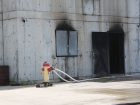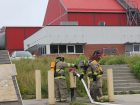
Features
Training
Back to Basics: August 2015
Getting water to and on the fire in a one- or two-storey residential building involves basic skills, but many firefighters struggle to proficiently execute those skills. Members of an engine company must work together to properly secure a water source, advance the hoseline, get water from the truck to the hoseline and then advance the hoseline inside to suppress or control the fire.
July 16, 2015
By Mark van der Feyst
Firefighters might find practising these skills boring and unnecessary, but the opposite needs to be emphasized. As basic as these skills are, they are the most important ones to know and to master. When firefighters can not quickly get water to and on the fire, a fire can grow in size and in intensity and an occupant or interior firefighter’s life can be in jeopardy. Inadequate water can also lead to building deterioration and collapse or other exposures catching on fire. After the fact, an insurance company or lawyer will closely examine the time it took to get water to and on the fire. If any delays are found, lawsuits and liability issues may develop.
So how can firefighters become more proficient at getting water to and on the fire? Examining each step in the process can help a fire department determine whether it is setting itself up for failure or on the path to success. Process evaluation can be done during a training drill – more specifically, a scenario-based training drill.
I like to use roll-in drills as a way to evaluate a crew’s competence. During the drill, examine the steps taken by the crew or individuals to complete the task. In this case, look at three key areas required to conduct a forward lay:
- Securing the hydrant or water source
- Advancing the preconnect hoseline
- Getting water from the truck to the nozzle
Securing the hydrant
Securing the water source is the first step. As the truck pulls up to the hydrant, one firefighter gets off, grabs the needed equipment, pulls off a section of large-diameter supply hose, walks to the hydrant, wraps the hose around the base of the hydrant and then, when ready, tells the driver to proceed down the road. The necessary equipment varies depending on the department’s operational practice, and may include a hydrant kit containing items such as:
- Hydrant wrenches
- 65-millimetre (2 1/2-inch) gate valve
- 100-millimetre (four-inch) Storz to thread adaptor
- Spanner wrenches
- Flashlight
- 100-millimetre (four-inch) gate valve
The hydrant kit should not be too heavy or so full that the firefighter who grabs it has a difficult time juggling it and the large-diameter supply hose, plus an SCBA.
The hydrant kit may be outfitted with different equipment depending upon the types of hydrants that are available in a department’s service area. In photo 1 the hydrant has just two 65-millimetre ports, which may require two 65-millimetre gate valves and also a 65 by 100-milliimetre adaptor so that a large-diameter hose can be connected.
In photo 2, the hydrant has two 65-millimetre ports as well as a 125-millimetre (five-inch) steamer port. The larger port allows for a higher flow rate of water without increasing the friction loss. This is where a 100-millimetre Storz thread adaptor is used to make the hose connection, or a 100-millimetre gate valve. Some of the newer hydrants have Storz connections already built in that allow direct hose-to-hydrant connections similar to a Storz coupling on two hoses.
The availability of intake size inlets on the fire truck pump panel also determines what’s in a hydrant equipment kit. Some fire trucks have just the standard 65-millimetre inlets and no large-diameter intake valve. There may be a port with a threaded connection, but no way of making the connection from a large-diameter hose to the fire truck pump. In photo 3, the only option is the 65-millimetre ports with two hoselines, as opposed to just one supply line.
Once the hydrant is secured, the firefighter needs to tell the pump operator when water can be sent from the hydrant to the truck. Once this is done, the firefighter can then return to the structure to be reassigned or to help with the initial attack.
In the next issue, we will look at advancing the preconnect hoseline and getting water from the truck to the nozzle.
Mark van der Feyst has been in the fire service since 1999 and is a full-time firefighter in Ontario. Mark teaches in Canada, the United States and India. He is a local-level suppression instructor for the Pennsylvania State Fire Academy and an instructor for the Justice Institute of BC. He is also the lead author of Pennwell’s Residential Fire Rescue book. Email Mark at Mark@FireStarTraining.com
Print this page


